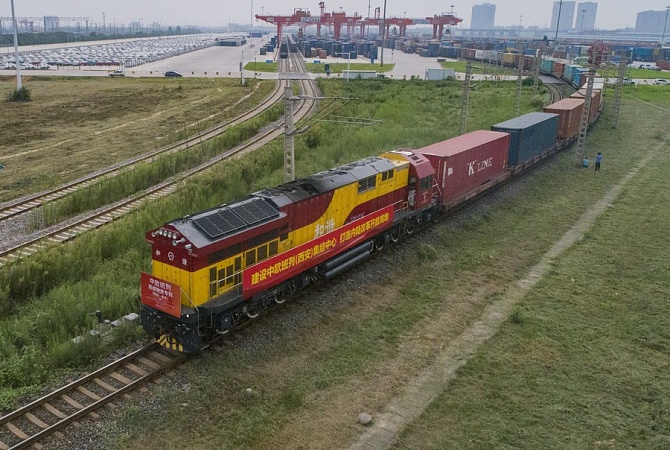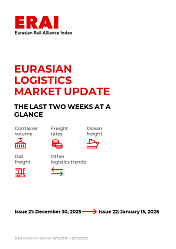— Launched in November 2013, the Chang’an trains have become a vital transport link between Europe and the city of Xi’an, capital of Shaanxi Province. The city was also where Zhang Qian, an envoy of the Western Han Dynasty (202 BC-25 AD), started his mission to the Western regions over 2,000 years ago, which eventually led to the opening of the Silk Road.
— In 2020, Xi’an became a distribution center for the China-Europe freight train service, realizing the interconnections between the inland city and major sources of goods in China, such as the Yangtze River Delta in the east and the Pearl River Delta in the south.
With Christmas just a month away, a company in northwest China’s Shaanxi Province has been producing at full speed and capacity, with LCD TVs rolling off the assembly line one after another.
These TVs are then loaded onto cross-border freight trains and hit the shelves of numerous stores in Europe in roughly two weeks, ready for the influx of holiday shoppers.
«Thanks to the stable and efficient operation of the Chang’an trains, the delivery time is cut by half,» said Qian Xilong, general manager of the Xi’an CCG Electronic Technology Co., Ltd.
«Sea shipping is still unpredictable due to the global COVID-19 situation, so many foreign buyers have shifted their orders to me,» he added.
Launched in November 2013, the Chang’an trains have become a vital transport link between Europe and the city of Xi’an, capital of Shaanxi Province.
The city was also where Zhang Qian, an envoy of the Western Han Dynasty (202 BC-25 AD), started his mission to the Western regions over 2,000 years ago, which eventually led to the opening of the Silk Road.
As of Nov. 20, the Chang’an trains had conducted a total of 10,963 trips. They are the busiest among all 70-plus routes of the China-Europe freight train service, connecting Xi’an with Central Asian and European destinations, including 45 cities in Belt and Road countries.
«Over 70 Chang’an trains are running every day, more than doubling the number in 2019,» said Shao Bo’er, general manager of the company that oversees the operation of the Chang’an trains.
The trains have provided strong support for international anti-pandemic cooperation. In 2020, some 56,000 tonnes of medical supplies were transported to Europe via the Chang’an trains.
There was a time when some trains came back to Xi’an with empty cars. But now, every returning train is fully packed, said Sun Yimin, director of the administrative committee of Xi’an International Trade and Logistics (ITL) Park.
Cookware from Germany, milk powder from the Netherlands and agricultural products from Central Asian countries are among the most popular imports delivered by the trains, according to Sun.
To build a highly efficient and low-cost international trading channel, the ITL Park has collaborated with both local and international logistics companies, including DHL and DB Schenker, to create global freight lines.
Because of the opening of a German fast line, the journey from Xi’an to Hamburg now takes 10 days, just three days more than air shipping.
In 2020, Xi’an became a distribution center for the China-Europe freight train service, realizing the interconnections between the inland city and major sources of goods in China, such as the Yangtze River Delta in the east and the Pearl River Delta in the south.
According to Sun, cargo from 29 provincial-level regions is assembled and distributed in Xi’an through multimodal transport such as rail-land transportation.
Shaanxi Siying, a computer monitor manufacturer once based in the southern metropolis of Shenzhen, moved to Xi’an in 2018.
«I chose Xi’an because of the Chang’an trains,» said the company’s founder Zhang Yiming. «In Shenzhen, it used to take more than a month to transport my products to Central Asia by sea, but now it only takes seven days by train.»
For western Chinese cities, the China-Europe freight trains offer a new logistics channel and help local businesses tap the potential of overseas markets.
According to Li Mingyuan, mayor of Xi’an, the freight train service is changing the industrial pattern of inland cities and boosting the opening-up of the ancient city of Xi’an.
Statistics show that in 2020, the total value of foreign trade of Xi’an reached 347.38 billion yuan (54.33 billion U.S. dollars), with a year-on-year increase of 7.2 percent.
Qian, of the CCG company, also moved his plant from Shenzhen in 2019 to the comprehensive bonded zone in the Xi’an ITL Park and is very proud of his timely and smart decision.
«We have quadrupled our sales in one year thanks to the Chang’an trains,» he said. «Many of my peers are envious of me now.»





